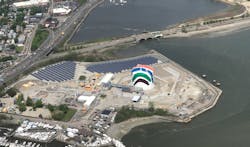ISO New England Outlook Good for Clean Energy
New England’s clean-energy goals can be achieved through the power of progress and competitive pricing, according to ISO New England in its 2021 Regional Electricity Outlook (REO).
ISO New England Inc. is the non-profit operator of the region’s bulk power system and wholesale electricity markets.
The outlook is one of the many ways the ISO keeps stakeholders informed about the current state of the grid, issues affecting its future, and ISO initiatives to ensure a modern, reliable power system for New England.
According to the outlook report, by the end of the decade there will be large clean energy resources added to the ISO New England mix, including 2,900 MW of energy efficiency, 3,500 MW of mostly distributed solar power and 1,400 MW of wind power, including the first offshore wind farm in the US.
By the end of the decade, 804 transmission projects totaling a $10.9 billion reliability investment will be completed, facilitating retirement of older fossil fuel resources and preparing for the delivery of additional clean energy.
Also, several New England states conduct RFPs and award long-term contracts for clean and renewable resources; proposals for renewable resources now outpace natural gas generation.
“This year’s REO, lays the groundwork for us to appreciate the region’s progress over the course of the past three decades, so we can better understand the path ahead,” said Gordon van Welie, CEO of ISO-NE. “Getting to our clean energy future won’t be easy, but our changing climate won’t wait; the time is now to set the region on the right course and ensure that as our economy is decarbonized, it is supported with a reliable, cost-effective, and clean energy grid.”
Progress in New England’s electricity industry has been on a continuous path since the 1990s, set by clear policy objectives that pursued twin goals of wholesale competition and system reliability. These changes spurred unprecedented investment in electric power infrastructure across the region.
Now, more recent policy initiatives have propelled the development of clean energy resources. The ISO’s job in the coming decades will be to ensure the power system can adjust to the changing mix of resources and modify the transmission system and wholesale markets as consumer demand grows due to the decarbonization of transportation and heating. All of this must be achieved without compromising the reliability New Englanders have come to depend on.
Pricing wholesale electricity has gone through many changes—and challenges—since industry restructuring started in the 1990s. When New England moved to restructure its electricity industry, the goal for the newly created competitive wholesale electricity markets was to lower costs, encourage innovation, and shield consumers from unwise investments. Responsive market design has been the guiding principle to ensuring that New England’s wholesale markets yield the benefits of efficiency and competition for the region.
We support the region’s clean energy transition, in partnership with the New England States and our regional stakeholders. The ISO has been working within its federally approved role and responsibility to adapt both its operations and markets so the grid stays reliable and prices competitive as our energy mix transitions from higher emitting to lower emitting resources, and eventually, to non-emitting resources.
